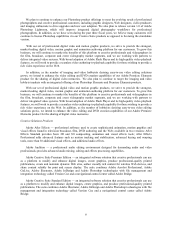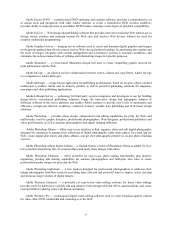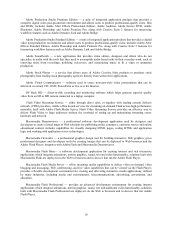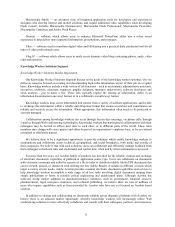Adobe 2006 Annual Report Download - page 18
Download and view the complete annual report
Please find page 18 of the 2006 Adobe annual report below. You can navigate through the pages in the report by either clicking on the pages listed below, or by using the keyword search tool below to find specific information within the annual report.18
Adobe LiveCycle Form Manager — a server-based software application which simplifies form management
and increases user satisfaction by centralizing the management of all forms, regardless of file type, into a single
point of access via a Web-based portal; allows administrators to manage form publication, version control and
user access, as well as establish ebXML relationships with business partners and customers inside and outside the
enterprise.
Adobe LiveCycle Forms — offers a range of solutions for deploying intelligent forms that can be completed
online or offline, across diverse platforms and devices; identifies a user’s environment to deliver the richest form-
filling capabilities supported and integrates with enterprise applications to pre-populate form fields, save captured
data, and initiate data-driven workflows.
Adobe LiveCycle Barcoded Forms — enables organizations to accurately capture user-supplied information
from fill-and-print paper forms by using dynamic 2D barcodes; barcodes are initially set up through creation of
the form with Adobe’s Designer application; after the form is printed, signed and returned by users of the form,
the barcode on the form is scanned and decoded, and form data obtained from the barcode is routed to the
appropriate enterprise application through Adobe’s LiveCycle server products.
Adobe LiveCycle Document Security — a server-based software application that helps organizations
automate the processing of electronic documents by providing batch-based capabilities to digitally sign and
certify PDF files, validate digital signatures, and encrypt/decrypt PDF documents; safeguards information when it
leaves a company’s network and integrates with existing public key infrastructures.
Adobe LiveCycle Policy Server — a server-based software application that helps organizations manage
information access securely with dynamic, persistent document control; allows for the control and monitoring of
PDF, Microsoft Word, Microsoft Excel and CATIA CAD document usage inside or outside the firewall, online or
offline, and across multiple document platforms; lets organizations know when a document has been viewed,
printed or altered, and restricts access so that only intended recipients can open, use and forward a document;
allows for previously granted document permissions and access to be revoked; leverages Adobe Acrobat and
Adobe Reader and other client plug-in software to author and view protected documents.
Adobe LiveCycle Reader Extensions — a server-based software application which lets enterprises easily
create and share interactive PDF files with external parties who must interact with these documents — without
requiring recipients of the documents to acquire Acrobat software that normally would be necessary to interact
with the PDF files they receive. On an individual PDF document, it unlocks features so that when such a file is
opened in the free Adobe Reader, users have access to functionality that normally would not be available in
Adobe Reader. Examples of document collaboration features that can be enabled in Adobe Reader by this server
product include the use of digital signatures to electronically sign PDF documents, the ability to ability to fill in,
submit, and save electronic documents locally, and the ability to fill-in form information.
Adobe LiveCycle PDF Generator — the next-generation replacement for Acrobat Distiller Server and
Acrobat Elements Server that offers server-based conversion of native PostScript, text, image formats, standard
office formats, and technical drawing formats into PDF files. LiveCycle PDF Generator integrates with other
LiveCycle products that apply digital rights management, document assembly, and process management to
converted documents in an automated fashion. The product can generate PDF files that comply with the new
PDF/A specification for long term document archives.
Adobe LiveCycle Workflow Server — a server-based process management application that allows for the
design, deployment and management of forms-based business processes to improve organizational agility and
productivity; uses a rules-and roles-based design tool that defines business rules a process must follow, as well as
the roles of each individual involved in the process.
Adobe Output Designer — a design tool that allows users to create electronic document templates for use
with Adobe solutions for document generation; aids in the creation of electronic documents that exactly replicate
existing paper documents.
























